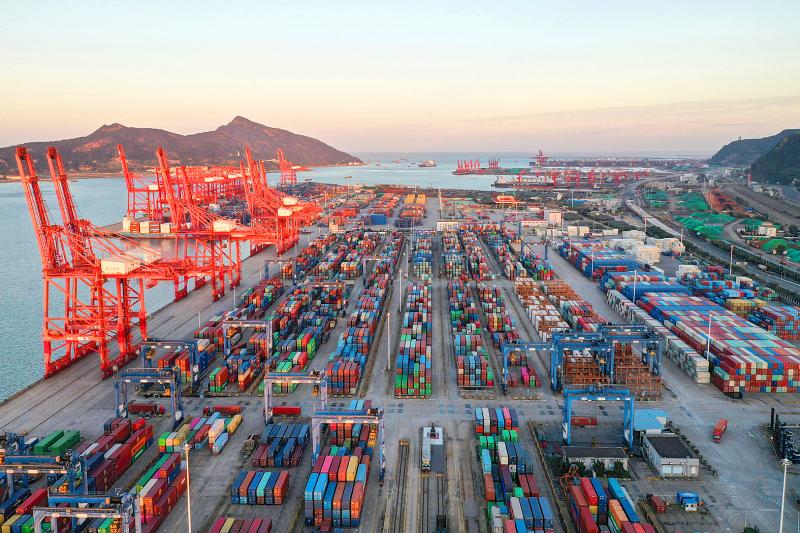China’s import and export growth slowed last month amid shipping bottlenecks and other disruptions combined with COVID-19 outbreaks, according to customs data reported yesterday.
The report showed exports rose 28.1 percent year-on-year to US$305.7 billion. That was slightly faster than the 26 percent increase logged in August and better than economists’ forecasts.
Imports rose 17.6 percent to US$240 billion, less than the previous month’s 33 percent.

Photo: AFP
This year’s trade figures have been distorted by comparison with last year, when global demand plunged in the first half after governments shut factories and shops to fight the COVID-19 pandemic.
“China’s foreign trade performance is leading the field among the world’s major economies and China has seen an increase in its international market share,” Chinese Customs Administration spokesman Li Kuiwen (李奎文) said.
“Taking into account the impact of the high base of foreign trade in 2020, the growth rate of imports and exports may fall in the fourth quarter of this year, but the overall upward trend of China’s foreign trade will not change and rapid growth throughout the year is still expected,” Li said.
Economists have forecast that surging global demand for Chinese goods would level off as disease prevention measures are eased, and entertainment, travel and other service industries reopen.
“The bigger problem for exports is that foreign demand has been buoyed by large stimulus in developed economies and shifts in consumption patterns due to the pandemic, both of which are likely to unwind over the coming quarters,” Julian Evans-Pritchard of Capital Economics said in a commentary.
He said imports are also likely to weaken as property construction slows and commodity prices retreat after surging in the initial rush of manufacturing as economies loosened disease prevention measures.
China’s global trade surplus rose to US$68 billion last month from US$52 billion in August. That was the highest level since 2015.
The politically sensitive trade surplus with the US rose to US$42 billion from nearly US$38 billion in August, the report said.
Southeast Asia was China’s biggest export market last month, reflecting expanding trade ties as nations lower tariffs and dismantle some barriers as part of regional trade agreements.
The data showed strong growth in shipments of vehicles, smartphones, auto parts and consumer electronics in the first nine months of the year.
Overall growth in two-way trade rose 15 percent in the third quarter, slowing from 25 percent year-on-year growth in the previous quarter.

GROWING OWINGS: While Luxembourg and China swapped the top three spots, the US continued to be the largest exposure for Taiwan for the 41st consecutive quarter The US remained the largest debtor nation to Taiwan’s banking sector for the 41st consecutive quarter at the end of September, after local banks’ exposure to the US market rose more than 2 percent from three months earlier, the central bank said. Exposure to the US increased to US$198.896 billion, up US$4.026 billion, or 2.07 percent, from US$194.87 billion in the previous quarter, data released by the central bank showed on Friday. Of the increase, about US$1.4 billion came from banks’ investments in securitized products and interbank loans in the US, while another US$2.6 billion stemmed from trust assets, including mutual funds,

Micron Memory Taiwan Co (台灣美光), a subsidiary of US memorychip maker Micron Technology Inc, has been granted a NT$4.7 billion (US$149.5 million) subsidy under the Ministry of Economic Affairs A+ Corporate Innovation and R&D Enhancement program, the ministry said yesterday. The US memorychip maker’s program aims to back the development of high-performance and high-bandwidth memory chips with a total budget of NT$11.75 billion, the ministry said. Aside from the government funding, Micron is to inject the remaining investment of NT$7.06 billion as the company applied to participate the government’s Global Innovation Partnership Program to deepen technology cooperation, a ministry official told the

Taiwan Semiconductor Manufacturing Co (TSMC, 台積電), the world’s leading advanced chipmaker, officially began volume production of its 2-nanometer chips in the fourth quarter of this year, according to a recent update on the company’s Web site. The low-key announcement confirms that TSMC, the go-to chipmaker for artificial intelligence (AI) hardware providers Nvidia Corp and iPhone maker Apple Inc, met its original roadmap for the next-generation technology. Production is currently centered at Fab 22 in Kaohsiung, utilizing the company’s first-generation nanosheet transistor technology. The new architecture achieves “full-node strides in performance and power consumption,” TSMC said. The company described the 2nm process as

Even as the US is embarked on a bitter rivalry with China over the deployment of artificial intelligence (AI), Chinese technology is quietly making inroads into the US market. Despite considerable geopolitical tensions, Chinese open-source AI models are winning over a growing number of programmers and companies in the US. These are different from the closed generative AI models that have become household names — ChatGPT-maker OpenAI or Google’s Gemini — whose inner workings are fiercely protected. In contrast, “open” models offered by many Chinese rivals, from Alibaba (阿里巴巴) to DeepSeek (深度求索), allow programmers to customize parts of the software to suit their